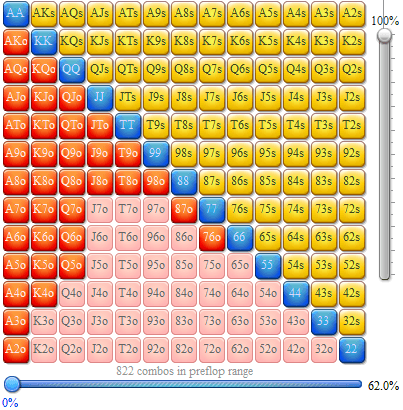Poker Probability Chart
Common Poker Hands Odds. Open-ended straight draws (4.8:1) An open-ended straight draw (OESD) is a straight draw that can be completed at either end. For example, holding 6. Four to a flush (4.1:1) Inside straight (10.5:1) One pair to two pair or trips (8.2:1) Overcards (6.7:1). The poker odds calculators on CardPlayer.com let you run any scenario that you see at the poker table, see your odds and outs, and cover the math of winning and losing poker hands. Texas Hold'em Omaha. The game is over when a single player has won all the money at the table. Although poker contains elements of randomness and gambling, there is a substantial amount of skill involved in understanding probability and game theory. Poker strategy typically involves an application of these concepts to improve one's chance of winning.
All of our poker charts will load as PDF files. This means you need to have Adobe Acrobat Reader, which is free software that’s normally installed on most computers. If you don’t have it installed then you can download it for free from Adobe.
The following charts will open in a new window and might take a few seconds to load, so please be patient.
A list of the standard poker hand rankings, from best to worst. It can be printed off and used as a handy reference for beginners who are just starting out.
This chart includes various probabilities and odds for many of the common events in Texas hold 'em. Committing these probabilities to memory can only be beneficial.
This chart lists the mathematical odds of hitting your outs from the flop to turn / turn to river / flop to river and can be used as a handy reference when calculating pot odds.
A starting hand chart for standard full ring no-limit hold'em games with 9 or 10 players. To be used as a general guide. Game conditions must always be taken into account.
A beginners guide to starting hand selection in limit hold'em full ring games with 9 or 10 players. Game conditions must always be taken into account.
Most Commonly Asked Poker Questions
Not sure what beats a full house or what a straight can beat? Here are the answers to the most commonly-asked poker questions this side of the Strip.
Does a flush beat a full house?
No. A full house beats a flush in the standard poker hand rankings. The odds against making a full house in a game of Texas Hold’em are about 36-to-1, while the odds against making a flush are 32-to-1. The full house is a more rare hand and beats a flush.
Does a flush beat a straight?
Yes. Using the standard poker hand rankings, a flush beats a straight, regardless of the strength of the straight. The odds against making a straight in Texas Hold’em are about 21-to-1, making it a more common hand than a flush (32-to-1 odds against).

Does a straight beat a full house?
No. The odds against making a full house in Texas Hold’em are about 36-to-1, while the odds against making a straight are about 21-to-1. Both are strong five-card hands, but a full house occurs less often than a straight. A full house beats a straight in the poker hand rankings.
Does three of a kind beat two pair?
Yes. Both three of a kind and two pair can make a lot of money in poker, but three of a kind is the best hand when it goes head to head with two pair. The odds against making three of a kind in Texas Hold’em is about 20-to-1, while the odds against making two pair is about 3-to-1.
Does three of a kind beat a straight?
No. The odds of making both of these hands are very close in a game of Texas Hold’em. The odds against making a straight are 20.6-to-1, while the odds against making three of a kind are 19.7-to-1. The straight comes about slightly less often, making it the winner against three of a kind in the poker hand rankings.
Does a flush beat three of a kind?
Poker Probability Chart
Yes. The battle of strong hands between a flush and three of a kind sees the flush as the stronger hand. The odds against making a flush in Texas Hold’em are about 32-to-1, with odds against making three of a kind at around 20-to-1.
Does a straight beat two pair?
Yes. The poker hand rankings dictate that a straight is a stronger hand than two pair. The straight occurs with about 21-to-1 odds against in Texas Hold’em, while the odds against making two pair stand at about 3-to-1.
Does four of a kind beat a full house?
Yes. Both four of a kind and a full house are among the strongest poker hands, but four of a kind is a much rarer holding. Texas Hold’em odds against making four of a kind are 594-to-1, while you have about 36-to-1 odds against making a full house.



Does three of a kind beat a flush?
Poker Starting Hand Odds Chart
No. When the flush and three of a kind go head to head, the flush comes out as the best according to the poker hand rankings. The odds against making three of a kind sit around 20-to-1, with the odds against hitting a flush at 32-to-1.
Does a full house beat a straight in poker?

Yes. The full house comes in less often than a straight. In Texas Hold’em, the odds against drawing a full house are around 36-to-1, while the odds against making a straight are around 21-to-1.
Does a straight flush beat four of a kind?
Poker Range Chart
Yes. Four of a kind is an exceedingly rare hand in poker, but the straight flush is an even more elusive five-card hand. The odds against making a straight flush in Texas Hold’em is about 3,590-to-1, much rarer than four of a kind (594-to-1 odds against)